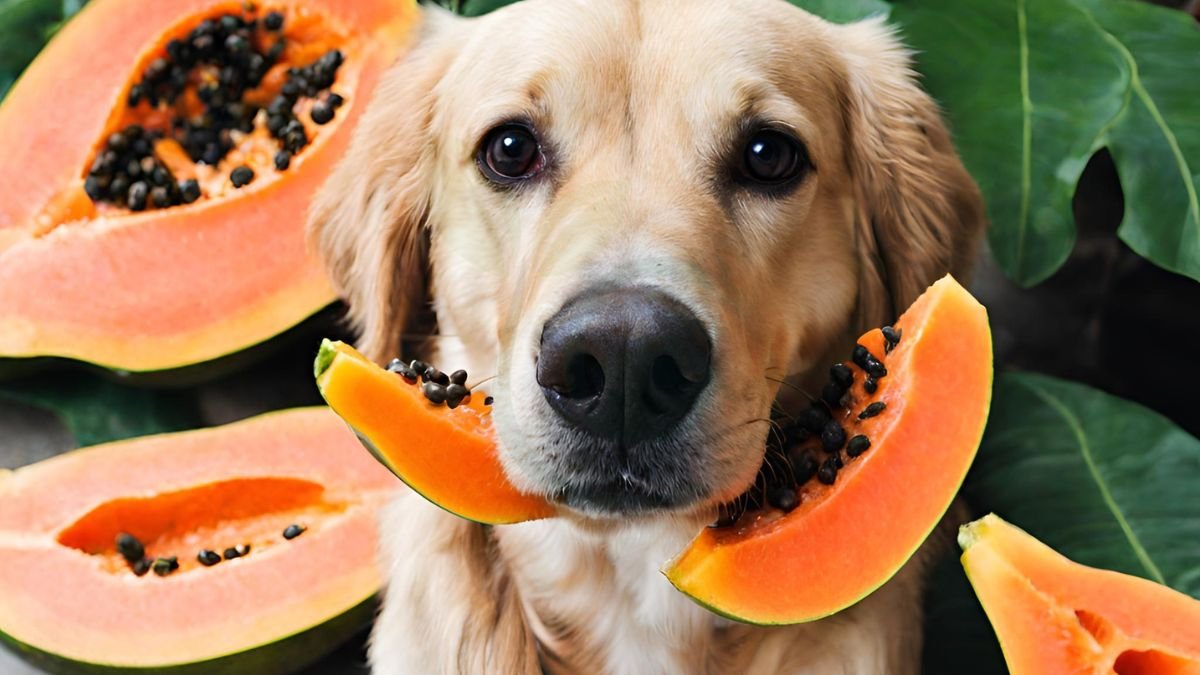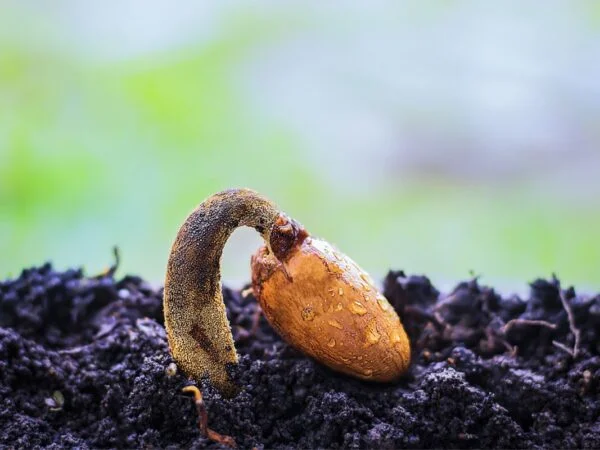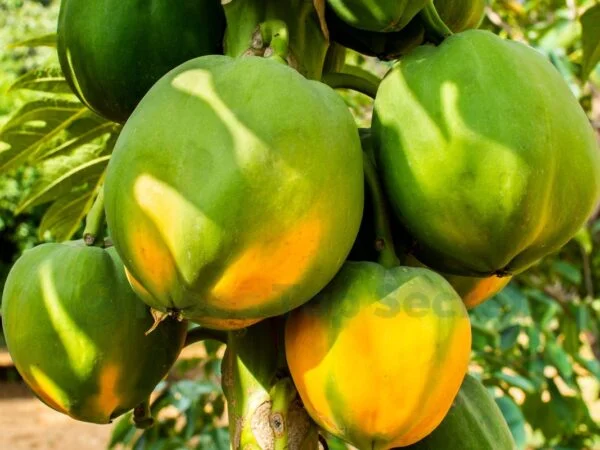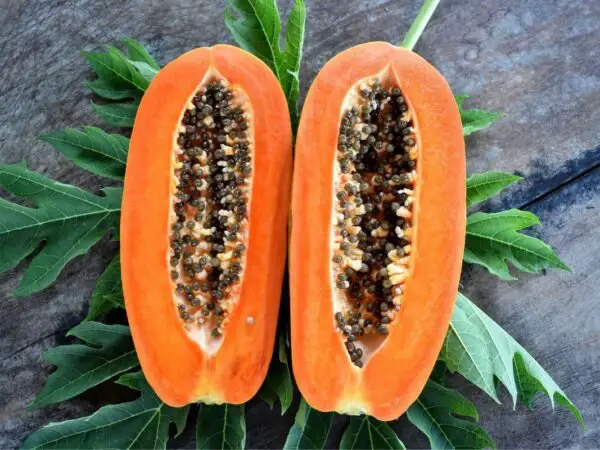Can dogs eat papaya? Absolutely! Papaya is generally safe for dogs to eat in moderation. It's a tropical fruit rich in vitamins A, C, and E, as well as fiber and antioxidants, which can contribute positively to a dog's diet.
Papaya contains enzymes like papain, which may aid in digestion. However, it's important to remove the seeds and skin before feeding papaya to your dog, as they can cause digestive issues or intestinal blockages. Additionally, some dogs may be allergic to papaya, so it's best to introduce it gradually and monitor for any adverse reactions. As with any new food, consulting with your veterinary is recommended to ensure it's suitable for your dog's specific dietary needs.
Consider incorporating papaya as an occasional treat for your furry friend, but always in moderation and alongside a balanced diet tailored to their nutritional requirements.
Key Takeaways
- Check with Veterinary: Consult your vet before introducing papaya or any new food to your dog's diet.
- Moderation is Key: Feed papaya to your dog in moderation to prevent digestive issues.
- Remove Seeds: Always remove the seeds from papaya before feeding it to your dog.
- Monitor for Allergies: Watch for any allergic reactions or sensitivities when feeding papaya to your dog.
- Nutritional Benefits: Papaya can offer various health benefits to dogs, like improved digestion and immune support.
- Diversify Food Products: Consider offering a variety of fruits in addition to papaya for a balanced diet.
Papaya Overview
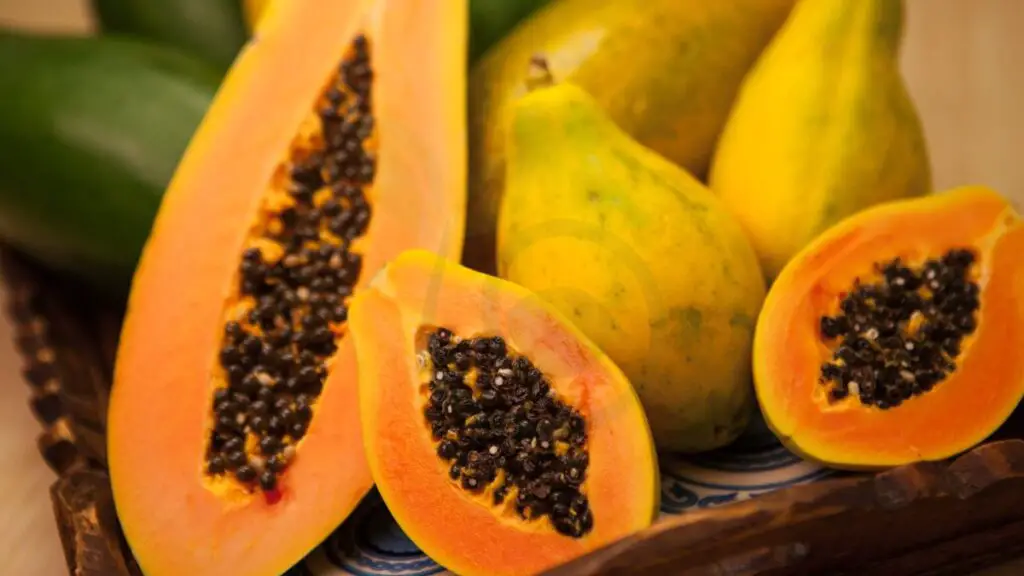
Nutritional Value
Papaya is rich in vitamins such as A, C, and E, along with minerals like potassium and magnesium. These nutrients are crucial for maintaining a dog's immune system, overall health, and wellness. Incorporating papaya into a dog's diet can provide them with essential vitamins and minerals necessary for their well-being.
Health Benefits
Papaya offers various health benefits to dogs, including supporting their immune system due to the presence of vitamin C. Enzymes like papain aid in improving digestion and providing anti-inflammatory properties. Including papaya in a dog's diet can help enhance their overall well-being and promote a healthy lifestyle.
Digestive Aid
Papaya acts as a natural digestive aid for dogs, thanks to its high fiber content. The fiber in papaya promotes healthy digestion by aiding in regular bowel movements and preventing constipation. For dogs experiencing digestive issues, incorporating papaya into their food can help alleviate these problems and improve their gastrointestinal wellness.
Can Dogs Eat Papaya

Safe Consumption
Feeding papaya to dogs can be safe if certain precautions are taken. Remove seeds and skin to prevent any potential digestive issues that may arise. Moderation is key when introducing papaya into a dog's diet to avoid any adverse effects.
Health Advantages
Incorporating papaya into a dog's diet can offer various health benefits. Boosting the immune system and aiding in digestion are some positive impacts of papaya consumption for dogs. It serves as a healthy food treat option, providing essential nutrients for overall wellness.
Preparing Papaya
Removing Seeds
Feeding papaya seeds to dogs, or any animal, can pose risks like intestinal blockage and cyanide toxicity. To safely prepare papaya for dogs, scoop out the seeds using a spoon. This process prevents potential choking hazards and ensures the safety of your furry friend.
Peeling Skin
Peeling the skin off papaya is essential as it contains latex that may be challenging for dogs to digest. By removing the skin, you reduce the risk of digestive discomfort in your pet. This step is crucial in ensuring that the papaya is easily digestible and safe for consumption.
Serving Size
When feeding papaya to dogs, moderation is key. The appropriate serving size depends on the size of your dog; generally, a few small pieces are sufficient. Overfeeding can lead to gastrointestinal upset or diarrhea in dogs. To prevent such issues, cut the papaya into small, bite-sized chunks for easy consumption.
Portion Guidelines
Size Considerations
Dogs' size directly influences the amount of papaya they can feed on. Small dogs should have smaller portions. For example, a small dog could have a teaspoon of papaya.
On the other hand, larger dogs can have slightly larger portions. A medium-sized dog may be given up to two tablespoons of papaya. Adjusting the portion based on the small pet's size is crucial to feed them wellness.
Frequency
Feeding papaya to dogs should be done in moderation regardless of their size. Dogs can enjoy papaya treats occasionally, not exceeding once or twice a week. Moderation is key in incorporating papaya into a dog's diet to avoid any digestive issues.
Benefits for Dogs
Immune Support
Papaya contains essential nutrients that can boost a dog's immune system, such as vitamins A and C. These vitamins play a crucial role in enhancing immunity and protecting dogs from illnesses. Papaya's nutrient content helps strengthen the body's defense mechanisms against infections and diseases.
The specific nutrients found in papaya, like vitamins A and C, are vital for maintaining a strong immune system in dogs. Vitamin A supports healthy vision and skin while also contributing to overall immune function. On the other hand, vitamin C acts as a powerful antioxidant that helps combat free radicals and reduce inflammation in the body.
Digestive Health
Papaya is beneficial for promoting healthy digestion in dogs due to the presence of the papain enzyme. This enzyme aids in breaking down proteins in food, facilitating better digestion and nutrient absorption. By including papaya in their diet, dogs can experience improved digestive efficiency and reduced gastrointestinal issues.
The papain enzyme found in papaya plays a significant role in aiding digestion by breaking down proteins effectively. This enzymatic activity supports smooth digestion processes, prevents bloating or gas formation, and enhances overall gut health in dogs. Including papaya as part of a dog's diet can help maintain a balanced and healthy digestive system.
Potential Risks
Choking Hazard
Feeding papaya to dogs, small pets, birds, or animals can pose a choking hazard if not prepared properly. Dogs may struggle with larger pieces of papaya, leading to potential choking incidents. To reduce this risk, it's crucial to cut papaya into small, bite-sized pieces before offering it to your furry friend. This simple step can significantly lower the chances of choking.
When giving papaya treats to your dog, ensure that the pieces are manageable in size. Large chunks can get lodged in their throat, causing distress and posing a serious choking risk. By slicing papaya into smaller portions, you make it easier for your dog to chew and swallow safely.
Allergic Reactions
While papaya is generally safe for dogs, there is a possibility of allergic reactions in some pets. Keep an eye out for signs such as itching, swelling, or digestive issues after feeding your dog papaya. If you notice any of these symptoms in your animal, bird, small pet, or dog, it's essential to consult your veterinarian immediately.
Signs of allergic reactions in dogs can vary from mild itching to severe swelling or difficulty breathing. If your animal shows any unusual symptoms after consuming papaya or other food, take prompt action by contacting your vet. It's crucial to act swiftly to address any potential allergic reactions and ensure the well-being of your pet.
Feeding Tips
Introducing Slowly
Introducing papaya slowly into a dog's diet is crucial to prevent digestive upsets. Start by offering small pieces of papaya as a treat. Gradually increase the amount over several days.
Monitor your dog for any signs of stomach upset or allergies during the introduction phase. Look for symptoms like vomiting, diarrhea, or changes in behavior. If any issues arise, stop feeding papaya immediately.
Monitoring Effects
It's essential to monitor how papaya affects dogs after it's introduced into their diet. Watch for signs of digestive issues, such as bloating or discomfort. Keep an eye out for any unusual behavior, changes in appetite, or health.
Regularly observe your dog's health and well-being when feeding them papaya. Ensure they are tolerating the fruit well without any adverse reactions. Consult your veterinarian if you notice any concerning symptoms.
Alternative Fruits
Safe Options
When it comes to feeding papaya to dogs, it's crucial to ensure that the fruit is ripe and fresh. Avoid feeding dogs papaya seeds as they can be harmful. Consider removing the skin and seeds before offering papaya to your furry friend.
To safely feed papaya to dogs, slice the fruit into small, bite-sized pieces. This helps prevent choking hazards and makes it easier for dogs to digest. Another safe option is blending papaya into a puree and mixing it with their regular food.
Choosing the right form of papaya for dogs is essential. Opt for fresh, organic papayas without any added sugars or preservatives. Avoid canned or processed papaya products as they may contain additives that are harmful to dogs.
Fruits to Avoid
e fruits are not safe for dogs to consume, including grapes, raisins, and citrus fruits like oranges and lemons. These fruits can be toxic to dogs and may lead to serious health issues such as kidney failure.
Feeding certain fruits to dogs can pose potential risks such as digestive upset, toxicity, and allergic reactions. It's important to be cautious when introducing new fruits into your dog's diet and monitor their reactions closely.
Instead of papaya, consider offering your dog other dog-friendly fruit options such as apples, bananas, and blueberries. These fruits are safe for dogs in moderation and provide essential nutrients that support their overall health.
Owner Testimonials
Positive Experiences
Dog owners have reported positive experiences after feeding papaya to their pets. Some have noticed improved digestion and firmer stools in their dogs by changing their food. Others have seen a reduction in stomach issues like bloating and gas.
- Papaya is praised for its high fiber content, aiding in smoother digestion for dogs.
- Owners have witnessed an increase in energy levels and overall vitality in their furry companions.
Incorporating papaya into a dog's diet has led to various benefits, including enhanced nutrient absorption and a boost in immune system function. The fruit's natural enzymes can aid in breaking down proteins and supporting digestive health.
Cautionary Tales
Despite the positive feedback, there are cautionary tales surrounding feeding papaya to dogs. Some incidents have highlighted potential risks such as allergic reactions or gastrointestinal upset in certain dogs when food or treats are involved. It's crucial to introduce new foods, treats, fish, and brands gradually to monitor any adverse reactions.
- Improper feeding of papaya can lead to stomach upset, diarrhea, or even allergic reactions in sensitive dogs.
- Consulting a veterinarian before introducing papaya ensures that it aligns with the dog's dietary needs and health conditions.
Following guidelines on portion sizes and preparation methods is essential to prevent any negative outcomes when feeding papaya to dogs. Pet owners should be cautious about the seeds present in papaya, as they can pose a choking hazard or cause intestinal blockages if consumed by dogs.
Closing Thoughts
Incorporating papaya into your dog's diet can offer numerous health benefits, from boosting their immune system to aiding digestion. Remember to remove the seeds and skin, and always introduce new foods gradually. Following portion guidelines is essential to prevent any potential risks associated with overfeeding. Keep an eye on your furry friend for any adverse reactions when introducing papaya for the first time.
We hope this guide has shed light on the question, "Can dogs eat papaya?" By following the feeding tips and considering alternative fruits, you can provide a well-rounded diet for your canine companion. Share your experience with other pet owners to spread awareness about safe and healthy fruit options for dogs.
Frequently Asked Questions
Can dogs safely eat papaya?
Yes, dogs can eat papaya in moderation. It is a healthy fruit for them, providing essential nutrients like fiber, vitamins A, C, and E. However, always remove the seeds and skin before feeding it to your dog.
Is papaya beneficial for dogs?
Papaya offers various benefits to dogs. It aids in digestion due to its enzyme called papain, boosts the immune system with its vitamin content, and supports overall health with its antioxidants.
How should I prepare papaya for my dog?
To prepare papaya for your dog, peel the fruit, remove the seeds as they can be toxic in large amounts, and cut it into small, bite-sized pieces to prevent choking hazards.
What are the potential risks of feeding papaya to dogs?
While papaya is generally safe for dogs, overfeeding can lead to digestive issues such as diarrhea or upset stomach. The seeds contain trace amounts of cyanide and should be avoided.
Are there any alternative fruits I can feed my dog besides papaya?
Yes, there are several fruits safe for dogs including apples (without seeds), bananas (in moderation), blueberries (high in antioxidants), and watermelon (seedless). Always introduce new foods gradually and monitor for any adverse reactions.
Image Source: Paid image from CANVA

